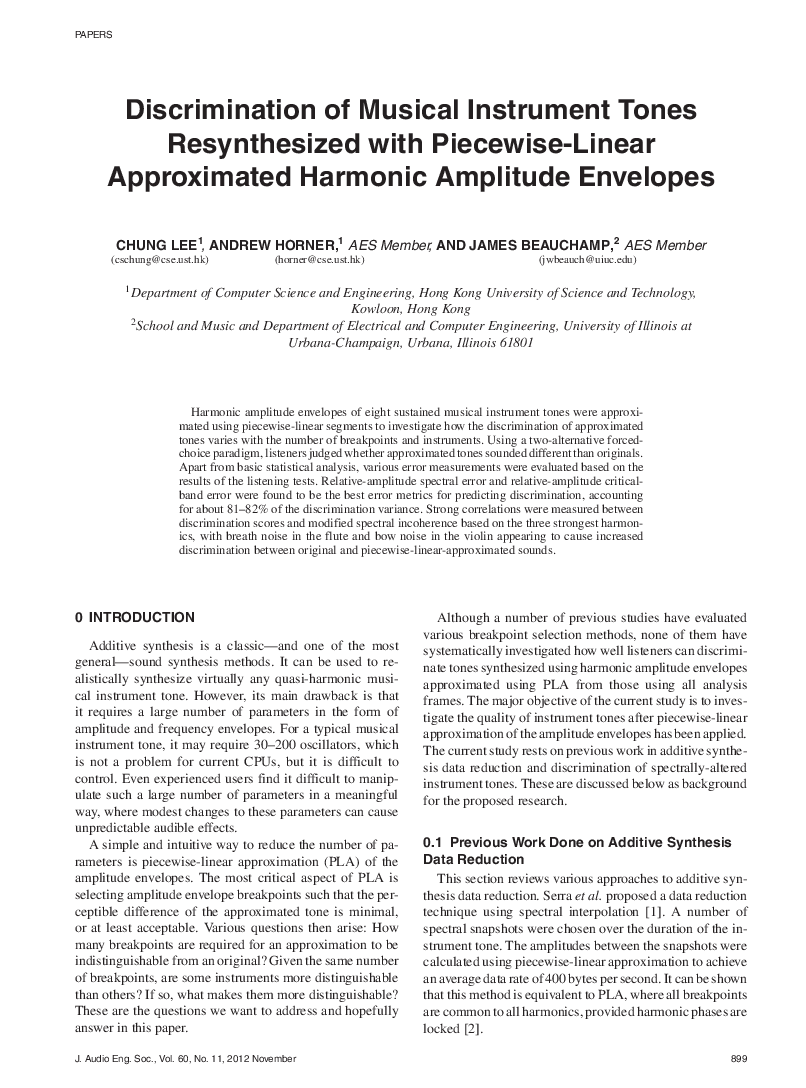Home / Publications / E-library page
You are currently logged in as an
Institutional Subscriber.
If you would like to logout,
please click on the button below.
Home / Publications / E-library page
Only AES members and Institutional Journal Subscribers can download
Quasi-harmonic musical instrument tones can be synthesized with various additive methods, but this approach requires a large number of parameters to describe the amplitude and frequency envelopes. Experienced users find it difficult to meaningfully manipulate so many parameters. A piecewise linear approximation with breakpoints reduces the data complexity. This study explores the perceptual implications of choosing the density of piecewise segments. Using a two-alternative forced-choice paradigm, listeners judged if the approximation was distinguishable from the original. Relative-amplitude spectral error and relative-amplitude critical-band error were found to be the best error metrics for predicting discrimination, accounting for about 80% of the discrimination variance. Strong correlations were observed between discrimination scores and the modified spectral incoherence based on the three strongest harmonics. Breath noise in the flute and bow noise in the violin appeared to cause increased discrimination issues.
Author (s): Lee, Chung; Horner, Andrew; Beauchamp, James
Affiliation:
Department of Computer Science and Engineering, Hong Kong University of Science and Technology, Kowloon, Hong Kong; School and Music and Department of Electrical and Computer Engineering, University of Illinois at Urbana-Champaign, Urbana, Illinois, USA
(See document for exact affiliation information.)
Publication Date:
2012-11-06
Import into BibTeX
Permalink: https://aes2.org/publications/elibrary-page/?id=16634
(360KB)
Click to purchase paper as a non-member or login as an AES member. If your company or school subscribes to the E-Library then switch to the institutional version. If you are not an AES member Join the AES. If you need to check your member status, login to the Member Portal.

Lee, Chung; Horner, Andrew; Beauchamp, James; 2012; Discrimination of Musical Instrument Tones Resynthesized with Piecewise-Linear Approximated Harmonic Amplitude Envelopes [PDF]; Department of Computer Science and Engineering, Hong Kong University of Science and Technology, Kowloon, Hong Kong; School and Music and Department of Electrical and Computer Engineering, University of Illinois at Urbana-Champaign, Urbana, Illinois, USA; Paper ; Available from: https://aes2.org/publications/elibrary-page/?id=16634
Lee, Chung; Horner, Andrew; Beauchamp, James; Discrimination of Musical Instrument Tones Resynthesized with Piecewise-Linear Approximated Harmonic Amplitude Envelopes [PDF]; Department of Computer Science and Engineering, Hong Kong University of Science and Technology, Kowloon, Hong Kong; School and Music and Department of Electrical and Computer Engineering, University of Illinois at Urbana-Champaign, Urbana, Illinois, USA; Paper ; 2012 Available: https://aes2.org/publications/elibrary-page/?id=16634
@article{lee2012discrimination,
author={lee chung and horner andrew and beauchamp james},
journal={journal of the audio engineering society},
title={discrimination of musical instrument tones resynthesized with piecewise-linear approximated harmonic amplitude envelopes},
year={2012},
volume={60},
issue={11},
pages={899-912},
month={december},}
TY – paper
TI – Discrimination of Musical Instrument Tones Resynthesized with Piecewise-Linear Approximated Harmonic Amplitude Envelopes
SP – 899 EP – 912
AU – Lee, Chung
AU – Horner, Andrew
AU – Beauchamp, James
PY – 2012
JO – Journal of the Audio Engineering Society
VO – 60
IS – 11
Y1 – December 2012